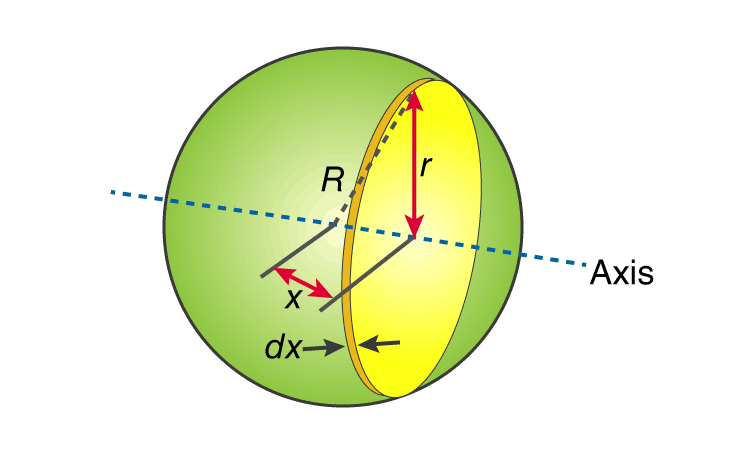The moment of inertia of a hollow sphere or a spherical shell is often determined by the following formula;
I = MR2
We will look at a simple problem to further understand the usage of the formula.
Let us calculate the moment of inertia of a hollow sphere having a mass of 55.0 kg and a radius of 0.120 m.
Now, to solve such problem we need to use the right formula which is;
I = (2/3)MR2
We will substitute the values,
I =(2/3) (55.0 kg)(0.120 m)2
I = (55.0 kg)(0.0144 m2)
I =(2/3) (0.792 kg.m2)
The moment of inertia of the hollow sphere is 0.528 kg.m2.
Hollow Sphere Formula Derivation
We will now understand the derivation of the moment of inertia formula for a hollow sphere.

- First, let us consider or recall the moment of inertia of a circle which is
I = mr2
If we apply differential analysis we get;
dl = r2 dm
- We have to find the dm,
dm = (M/A) dA
Here, A is the total surface area of the shell = 4πR2 (Total surface area of the shell)
dA is the area of the ring formed by differentiation and is expressed as;
dA = R dθ × 2πr
2πr is the circumference of the ring
R dθ is the thickness of the circular ring
Note: We get R dθ from the equation of arc length which is S = R θ
- The next step involves relating r with θ.
If we look at the diagram that is given above, we will see that a right angle triangle with angle θ is present.
We get,
sin θ = r /R
r = R sin θ
Now dA becomes:
dA = Rdθ × 2πRsinθ
dA = 2πR2sinθ dθ
If we substitute the equation for dA into dm, we get:
dm = (M/A) dA
dm = (M/4πR2)2πR2sinθ dθ
dm = (M/2)sin2θ dθ
We will now substitute the equation given above and for r into the equation for dI. We will get;
dI = r2(M/2)sin2θ dθ
= (Rsinθ)2(M/2)sin2θ dθ
= (MR2/2)sin3θ dθ
Now, we need to split the sin3θ into two, as it depicts the case of integral of odd powered trigonometrical functions. We get;
dI =(MR2/2) sin2 θ sin θ dθ
However, sin2 θ is normally given as sin2 θ = 1- cos2 θ. Now,
dI = (MR2/2) (1- cos2 θ) sin θ dθ
Integrating within the limits of 0 to π radians. From one end to another.
After this, we use substitution where u = cos θ.
I =(MR2/2) {[ u3/3]1-1 – [u]1-1
I =(MR2/2) {(1/3)[ (-1)3 -13] – [-1-1]}
I = (MR2/2){[-1-1]/3 – [-2]}
I =(MR2/2) { [(-2/3) +2]}
I = (MR2/2) x (4/3)
I = (2/3) MR2
Comments